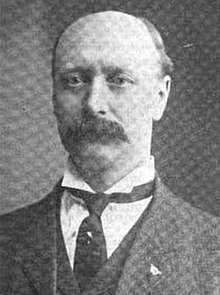Robert Logan (naval architect)
Robert Logan (March 14, 1861 – July 22, 1918) was a Scottish naval architect. He designed the first steel train ferry. This was followed by several more steel train ferries that ultimately developed into the world's largest carferry fleet.
Robert Logan | |
|---|---|
 Robert Logan, circa 1911 | |
| Born | March 14, 1861 Glasgow, Scotland |
| Died | July 22, 1918 (aged 57) Cleveland, Ohio |
| Alma mater | University of Glasgow Royal College of Science and Technology |
| Occupation | Architect |
| Practice | Naval architect |
Early life
Logan was born in Glasgow, Scotland, March 14, 1861. He was a graduate of the University of Glasgow and of the Royal College of Science and Technology in Glasgow. In 1882 he won the Queen's Prize for mathematics for a college scholarship.[2]
Mid life and career
Logan became chief draftsman for the shipbuilding firm of Mansell and Aiken in Glasgow after graduation. Here he gained shipbuilding experience on the River Clyde, where the firm was located.[3] Logan immigrated to Canada in June 1888 and settled in Owen Sound in Ontario. There he got a job as the superintendent of construction of vessels for the Canadian Pacific Railway (CPR). One of the steamships he was involved with on its construction was the SS Manitoba built in 1888–89. This passenger steel ship was 320-foot (98 m) long and one of the first large metal ones built in Canada. It was in connection with the building of the steamer Manitoba that A.O. Rankin met Logan, who had gone to Canada in the interests of the CPR to superintend the building of this steamer.[3]
Logan eventually opened his own design firm with A. O. Rankin in Toronto after working for the railroad for several years. The naval architect firm name was Logan & Rankin and they became marine engineers. Logan moved to Cleveland, Ohio, in 1893 and became general manager of the American Shipbuilding Company. He designed large freighters for use on the Great Lakes. Logan designed several ships for railroad companies between 1895 and 1910.[3] The Flint and Pere Marquette Railroad ordered eight carferries to be designed by Logan.[4] Their first carferry was the SS Pere Marquette, the first steel train ferry in history and Logan was specifically selected to design it.[5][6] This carferry was designed as a cross-lake ferry, the first all steel one in the world.[3][7][8] The "Logan boats" had pilot houses with open upper levels and elevated bridge wings, twin smoke stacks with a slight angle slant, and no sea-gate.[3][8]
Organizations
Logan was a Thirty-second Degree Mason, Mystic Shrine, Scottish Rite, and a life member of the Benevolent and Protective Order of Elks.
Later life and death
Logan was general manager for the American Shipbuilding Company until his resignation in 1910. He then maintained a private office in Cleveland as a consulting engineer, which he operated until his death. He died in his home in Cleveland on July 22, 1918.[9]
References
- Penton 1911, p. 159.
- Peterson, Paul S. (March 18, 1997). "Scottish man designs six of the local fleet". Ludington Daily News. Ludington, Michigan. p. 3.
- "Seven Have Directed Freight Operations across Lake". Daily News. Ludington, Michigan. October 23, 1952 – via Newspapers.com

- Car Ferry-Boat Pere Marquette, The Railroad Gazette, p. 113,
Robert Logan of Cleveland who has supervised her construction was the architect.
- "First Steel Carferry Made Maiden Voyage 55 Years Ago Today". Daily News. Ludington, Michigan. February 19, 1952 – via Newspapers.com

She had been designed by Robert Logan of Cleveland.
- Mac Laren, Agnes E. (January 4, 1957). "This and That from History". Daily News. Ludington, Michigan – via newspapers.com

The Pere Marquette, which was the widest steamer on the Great Lakes, was the first steel carferry in the world. She was designed by Robert Logan of Cleveland.
- Bagley, Les (June 7, 2007). "Autos Across Mackinac: Pere Marquette Makes New Home in St. Ignace". St. Ignace News. Archived from the original on July 29, 2017. Retrieved July 9, 2017.
- Penton_Steel 1918, p. 345.
Sources
- Naval Architects (1919). Society of Naval Architects. SNAME.CS1 maint: ref=harv (link)
- Penton (1911). Marine Review. Penton Publishing Company.CS1 maint: ref=harv (link)
- Penton_Steel (1918). Steel, Volume 63. Penton Publishing Company.CS1 maint: ref=harv (link)